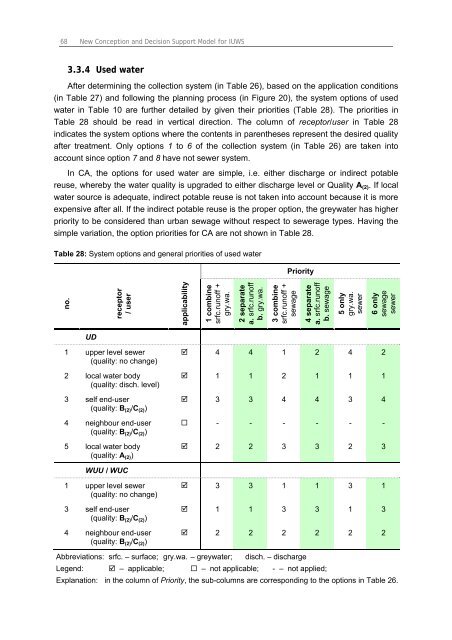Chapter 3 Decision Support Model (IUWS-DSM) - Tubdok
Chapter 3 Decision Support Model (IUWS-DSM) - Tubdok
Chapter 3 Decision Support Model (IUWS-DSM) - Tubdok
You also want an ePaper? Increase the reach of your titles
YUMPU automatically turns print PDFs into web optimized ePapers that Google loves.
68 New Conception and <strong>Decision</strong> <strong>Support</strong> <strong>Model</strong> for <strong>IUWS</strong><br />
3.3.4 Used water<br />
After determining the collection system (in Table 26), based on the application conditions<br />
(in Table 27) and following the planning process (in Figure 20), the system options of used<br />
water in Table 10 are further detailed by given their priorities (Table 28). The priorities in<br />
Table 28 should be read in vertical direction. The column of receptor/user in Table 28<br />
indicates the system options where the contents in parentheses represent the desired quality<br />
after treatment. Only options 1 to 6 of the collection system (in Table 26) are taken into<br />
account since option 7 and 8 have not sewer system.<br />
In CA, the options for used water are simple, i.e. either discharge or indirect potable<br />
reuse, whereby the water quality is upgraded to either discharge level or Quality A(2). If local<br />
water source is adequate, indirect potable reuse is not taken into account because it is more<br />
expensive after all. If the indirect potable reuse is the proper option, the greywater has higher<br />
priority to be considered than urban sewage without respect to sewerage types. Having the<br />
simple variation, the option priorities for CA are not shown in Table 28.<br />
Table 28: System options and general priorities of used water<br />
no.<br />
UD<br />
receptor<br />
/ user<br />
1 upper level sewer<br />
(quality: no change)<br />
2 local water body<br />
(quality: disch. level)<br />
3 self end-user<br />
(quality: B(2)/C(2))<br />
4 neighbour end-user<br />
(quality: B(2)/C(2))<br />
5 local water body<br />
(quality: A(2))<br />
WUU / WUC<br />
1 upper level sewer<br />
(quality: no change)<br />
3 self end-user<br />
(quality: B(2)/C(2))<br />
4 neighbour end-user<br />
(quality: B(2)/C(2))<br />
applicability<br />
1 combine<br />
srfc.runoff +<br />
gry.wa.<br />
2 separate<br />
a. srfc.runoff<br />
b. gry.wa.<br />
3 combine<br />
srfc.runoff +<br />
sewage<br />
Priority<br />
4 separate<br />
a. srfc.runoff<br />
b. sewage<br />
5 only<br />
gry.wa.<br />
sewer<br />
6 only<br />
sewage<br />
sewer<br />
� 4 4 1 2 4 2<br />
� 1 1 2 1 1 1<br />
� 3 3 4 4 3 4<br />
� - - - - - -<br />
� 2 2 3 3 2 3<br />
� 3 3 1 1 3 1<br />
� 1 1 3 3 1 3<br />
� 2 2 2 2 2 2<br />
Abbreviations: srfc. – surface; gry.wa. – greywater; disch. – discharge<br />
Legend: � – applicable; � – not applicable; - – not applied;<br />
Explanation: in the column of Priority, the sub-columns are corresponding to the options in Table 26.

















